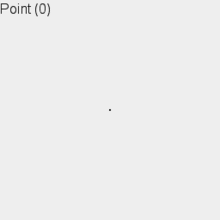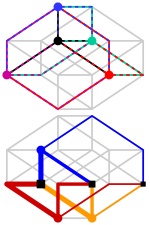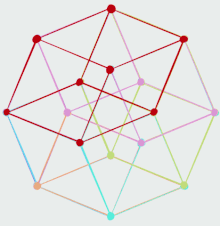

In geometry, a tesseract or 4-cube is a four-dimensional hypercube, analogous to a two-dimensional square and a three-dimensional cube.[1] Just as the perimeter of the square consists of four edges and the surface of the cube consists of six square faces, the hypersurface of the tesseract consists of eight cubical cells, meeting at right angles. The tesseract is one of the six convex regular 4-polytopes.
The tesseract is also called an 8-cell, C8, (regular) octachoron, or cubic prism. It is the four-dimensional measure polytope, taken as a unit for hypervolume.[2] Coxeter labels it the γ4 polytope.[3] The term hypercube without a dimension reference is frequently treated as a synonym for this specific polytope.
The Oxford English Dictionary traces the word tesseract to Charles Howard Hinton's 1888 book A New Era of Thought. The term derives from the Greek téssara (τέσσαρα 'four') and aktís (ἀκτίς 'ray'), referring to the four edges from each vertex to other vertices. Hinton originally spelled the word as tessaract.[4]
As a regular polytope with three cubes folded together around every edge, it has Schläfli symbol {4,3,3} with hyperoctahedral symmetry of order 384. Constructed as a 4D hyperprism made of two parallel cubes, it can be named as a composite Schläfli symbol {4,3} × { }, with symmetry order 96. As a 4-4 duoprism, a Cartesian product of two squares, it can be named by a composite Schläfli symbol {4}×{4}, with symmetry order 64. As an orthotope it can be represented by composite Schläfli symbol { } × { } × { } × { } or { }4, with symmetry order 16.
Since each vertex of a tesseract is adjacent to four edges, the vertex figure of the tesseract is a regular tetrahedron. The dual polytope of the tesseract is the 16-cell with Schläfli symbol {3,3,4}, with which it can be combined to form the compound of tesseract and 16-cell.
Each edge of a regular tesseract is of the same length. This is of interest when using tesseracts as the basis for a network topology to link multiple processors in parallel computing: the distance between two nodes is at most 4 and there are many different paths to allow weight balancing.
A tesseract is bounded by eight three-dimensional hyperplanes. Each pair of non-parallel hyperplanes intersects to form 24 square faces. Three cubes and three squares intersect at each edge. There are four cubes, six squares, and four edges meeting at every vertex. All in all, a tesseract consists of 8 cubes, 24 squares, 32 edges, and 16 vertices.
A unit tesseract has side length 1, and is typically taken as the basic unit for hypervolume in 4-dimensional space. The unit tesseract in a Cartesian coordinate system for 4-dimensional space has two opposite vertices at coordinates [0, 0, 0, 0] and [1, 1, 1, 1], and other vertices with coordinates at all possible combinations of 0s and 1s. It is the Cartesian product of the closed unit interval [0, 1] in each axis.
Sometimes a unit tesseract is centered at the origin, so that its coordinates are the more symmetrical This is the Cartesian product of the closed interval in each axis.
Another commonly convenient tesseract is the Cartesian product of the closed interval [−1, 1] in each axis, with vertices at coordinates (±1, ±1, ±1, ±1). This tesseract has side length 2 and hypervolume 24 = 16.
An unfolding of a polytope is called a net. There are 261 distinct nets of the tesseract.[5] The unfoldings of the tesseract can be counted by mapping the nets to paired trees (a tree together with a perfect matching in its complement).

The construction of hypercubes can be imagined the following way:
The 8 cells of the tesseract may be regarded (three different ways) as two interlocked rings of four cubes.[6]
The tesseract can be decomposed into smaller 4-polytopes. It is the convex hull of the compound of two demitesseracts (16-cells). It can also be triangulated into 4-dimensional simplices (irregular 5-cells) that share their vertices with the tesseract. It is known that there are 92487256 such triangulations[7] and that the fewest 4-dimensional simplices in any of them is 16.[8]
The dissection of the tesseract into instances of its characteristic simplex (a particular orthoscheme with Coxeter diagram ![]()
![]()
![]()
![]()
![]()
![]()
![]() ) is the most basic direct construction of the tesseract possible. The characteristic 5-cell of the 4-cube is a fundamental region of the tesseract's defining symmetry group, the group which generates the B4 polytopes. The tesseract's characteristic simplex directly generates the tesseract through the actions of the group, by reflecting itself in its own bounding facets (its mirror walls).
) is the most basic direct construction of the tesseract possible. The characteristic 5-cell of the 4-cube is a fundamental region of the tesseract's defining symmetry group, the group which generates the B4 polytopes. The tesseract's characteristic simplex directly generates the tesseract through the actions of the group, by reflecting itself in its own bounding facets (its mirror walls).
The radius of a hypersphere circumscribed about a regular polytope is the distance from the polytope's center to one of the vertices, and for the tesseract this radius is equal to its edge length; the diameter of the sphere, the length of the diagonal between opposite vertices of the tesseract, is twice the edge length. Only a few uniform polytopes have this property, including the four-dimensional tesseract and 24-cell, the three-dimensional cuboctahedron, and the two-dimensional hexagon. In particular, the tesseract is the only hypercube (other than a zero-dimensional point) that is radially equilateral. The longest vertex-to-vertex diagonal of an -dimensional hypercube of unit edge length is which for the square is for the cube is and only for the tesseract is edge lengths.
An axis-aligned tesseract inscribed in a unit-radius 3-sphere has vertices with coordinates

For a tesseract with side length s:
This configuration matrix represents the tesseract. The rows and columns correspond to vertices, edges, faces, and cells. The diagonal numbers say how many of each element occur in the whole tesseract. The nondiagonal numbers say how many of the column's element occur in or at the row's element.[9] For example, the 2 in the first column of the second row indicates that there are 2 vertices in (i.e., at the extremes of) each edge; the 4 in the second column of the first row indicates that 4 edges meet at each vertex.
It is possible to project tesseracts into three- and two-dimensional spaces, similarly to projecting a cube into two-dimensional space.


The cell-first parallel projection of the tesseract into three-dimensional space has a cubical envelope. The nearest and farthest cells are projected onto the cube, and the remaining six cells are projected onto the six square faces of the cube.
The face-first parallel projection of the tesseract into three-dimensional space has a cuboidal envelope. Two pairs of cells project to the upper and lower halves of this envelope, and the four remaining cells project to the side faces.
The edge-first parallel projection of the tesseract into three-dimensional space has an envelope in the shape of a hexagonal prism. Six cells project onto rhombic prisms, which are laid out in the hexagonal prism in a way analogous to how the faces of the 3D cube project onto six rhombs in a hexagonal envelope under vertex-first projection. The two remaining cells project onto the prism bases.
The vertex-first parallel projection of the tesseract into three-dimensional space has a rhombic dodecahedral envelope. Two vertices of the tesseract are projected to the origin. There are exactly two ways of dissecting a rhombic dodecahedron into four congruent rhombohedra, giving a total of eight possible rhombohedra, each a projected cube of the tesseract. This projection is also the one with maximal volume. One set of projection vectors are u = (1,1,−1,−1), v = (−1,1,−1,1), w = (1,−1,−1,1).

The tesseract, like all hypercubes, tessellates Euclidean space. The self-dual tesseractic honeycomb consisting of 4 tesseracts around each face has Schläfli symbol {4,3,3,4}. Hence, the tesseract has a dihedral angle of 90°.[10]
The tesseract's radial equilateral symmetry makes its tessellation the unique regular body-centered cubic lattice of equal-sized spheres, in any number of dimensions.
The tesseract is 4th in a series of hypercube:
The tesseract (8-cell) is the third in the sequence of 6 convex regular 4-polytopes (in order of size and complexity).
As a uniform duoprism, the tesseract exists in a sequence of uniform duoprisms: {p}×{4}.
The regular tesseract, along with the 16-cell, exists in a set of 15 uniform 4-polytopes with the same symmetry. The tesseract {4,3,3} exists in a sequence of regular 4-polytopes and honeycombs, {p,3,3} with tetrahedral vertex figures, {3,3}. The tesseract is also in a sequence of regular 4-polytope and honeycombs, {4,3,p} with cubic cells.
The regular complex polytope 4{4}2, ![]()
![]()
![]() , in has a real representation as a tesseract or 4-4 duoprism in 4-dimensional space. 4{4}2 has 16 vertices, and 8 4-edges. Its symmetry is 4[4]2, order 32. It also has a lower symmetry construction,
, in has a real representation as a tesseract or 4-4 duoprism in 4-dimensional space. 4{4}2 has 16 vertices, and 8 4-edges. Its symmetry is 4[4]2, order 32. It also has a lower symmetry construction, ![]()
![]()
![]() , or 4{}×4{}, with symmetry 4[2]4, order 16. This is the symmetry if the red and blue 4-edges are considered distinct.[11]
, or 4{}×4{}, with symmetry 4[2]4, order 16. This is the symmetry if the red and blue 4-edges are considered distinct.[11]
Since their discovery, four-dimensional hypercubes have been a popular theme in art, architecture, and science fiction. Notable examples include:
The word tesseract has been adopted for numerous other uses in popular culture, including as a plot device in works of science fiction, often with little or no connection to the four-dimensional hypercube; see Tesseract (disambiguation).